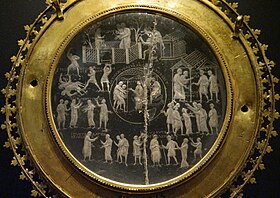Lothar Crystal
 |
|
| Material |
Quartz Gilt copper (frame) |
|---|---|
| Size | Weight: 650 grammes (incl frame) Diameter: 115 mm (4.5 in) (crystal) Diameter: 183 mm (7.2 in) (incl frame) Thickness: 13 mm (0.51 in) |
| Writing | Latin |
| Created | 15th century (frame), 855-869 (crystal) |
| Period/culture | Carolingian (crystal), Medieval (frame) |
| Place | Meuse, River |
| Present location | Room 41, British Museum |
| Identification | BL.1295; 1855,1201.5 |
The Lothair Crystal (also known as the Lothar Crystal or the Susanna Crystal) is an engraved gem from Lotharingia in North-West Europe, showing scenes of the biblical story of Susanna, dating from 855-869. The Lothair Crystal is an object in the collection of the British Museum.
The original element of the work is a circular disc of clear quartz ("rock crystal"), measuring 11.5 centimetres (4.5 in) in diameter. This is engraved in intaglio with eight scenes depicting the story of Susanna and the Elders, related in the Book of Daniel (but regarded as part of the Apocrypha by Protestants). Susanna is first shown being falsely accused and condemned for adultery by the elders. Daniel intervenes to question the elders, uncovers their false witness and engineers their execution by stoning. In the final scene, Susanna is declared to be innocent. The scenes are accompanied by brief inscriptions in Latin drawn from the Vulgate Bible.
The engravings on the crystal are executed in the energetic and distinctive early mediæval Rheims style which originated in manuscript drawings such as those in the Utrecht Psalter. The crystal is surrounded by a 15th-century gilt-copper mount with a foliage border, which was once attributed to Saint Eligius (c. 588 – 660), the patron saint of goldsmiths.
The crystal is inscribed LOTHARIVS REX FRANCORVM IVSSIT ("Lothair, King of the Franks, caused [this to be made]"), apparently Lothair II, or "Lothar" in German. The elder Lothair styled himself imperator (emperor), whereas the younger man only called himself rex (king), as does the owner of the crystal; it is therefore probable that it was created in Lothair II's time, probably around the middle of the 9th century, making it a late example of Carolingian art.
...
Wikipedia
